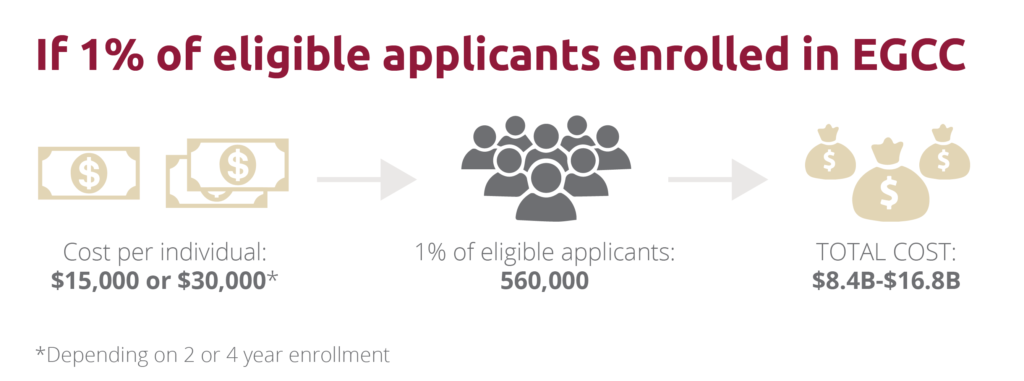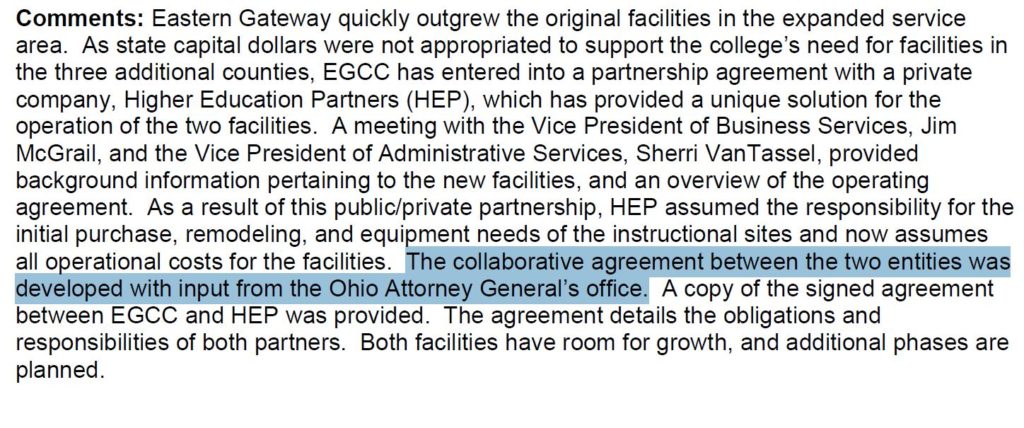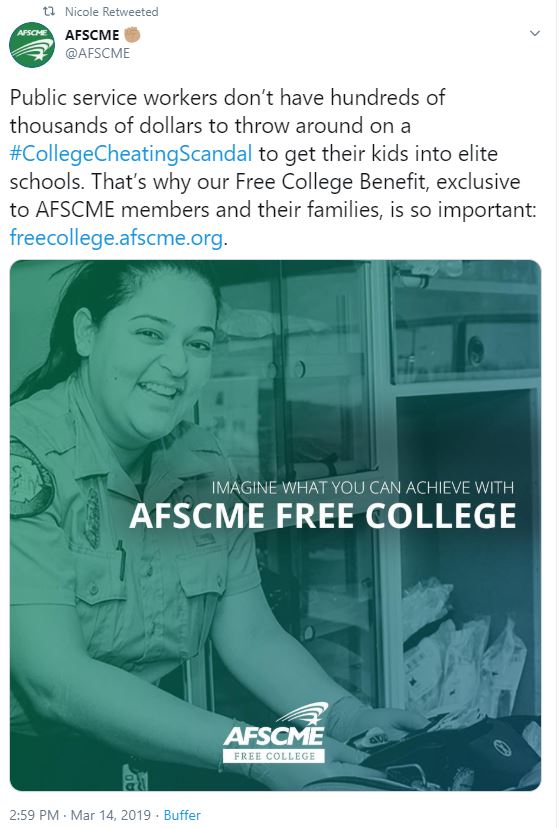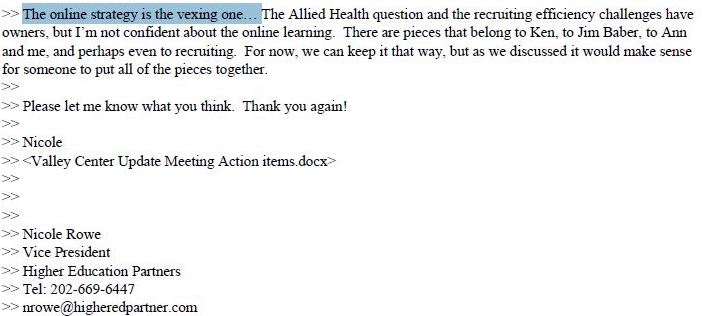The following report details how a community college funneled millions of taxpayer dollars into a program for free college for union members and their families. According to legally obtained internal emails and documents, the “free college” program was created by political players who benefited financially from its creation and had ties to union leaders.
Of course “free” college isn’t free. Someone has to pay for it.
So when Ohio-based Eastern Gateway Community College partnered with a company that offered “free” community college to union members and their families from all 50 states, it was part of the plan to have taxpayers subsidize the program. And the unions’ corporate partners would share in the profits.
The program is called the “Union Plus Free College Benefit.” Multiple national unions partnered with Eastern Gateway and two private companies to offer the tuition-free online college degree program to union members and their families. Even though most of the new students were from out-of-state, the college still received state funding for the new enrollees.
The unions, their corporate partners, and the college exploited a unique loophole that existed in Ohio – state money went to colleges both for in-state and out-of-state students. Most states do not provide subsidies for out-of-state students, but in Ohio, colleges received money based on their total enrollment.
But colleges compete against one another for a single pot of money, so when Eastern Gateway boosted their enrollment figures by offering free college to union members and their families, they were able to siphon millions of state dollars away from other Ohio community colleges.
The harm caused to other Ohio community colleges because of this plan was pointed out at a June 2019 hearing of the Ohio Senate Finance Committee. Chairman Matt Dolan (R-Chagrin Falls) asked Jimmie Bruce, then president of Eastern Gateway, why it made sense to pull dollars from other Ohio community colleges to pay for online degrees for students from other states.
“When you are saying we are counting students in California who will never step foot in Ohio, and probably never work here in Ohio, as students subject to the (state funding) formula, what will happen very shortly is your enrollment of (out-of-state) kids will greatly cripple the rest of the community colleges’ access to (state) dollars,” said Dolan.
Bruce told Sen. Dolan he understood the state may need to stop the flow of funds toward the free college program for out-of-state students but asked the state to phase-in the decrease. Ohio stopped counting out-of-state students for the community college subsidy starting in July 2020, according to Jeff Robinson, a spokesperson for the Ohio Department of Higher Education.
Eastern Gateway and Ohio’s State Central University, which recently joined the program, continue to advertise the free college program to union members and their families.
Other Ohio community college leaders raised concerns about the program. A few months before the Senate hearing, Jack Hershey, president of the Ohio Association of Community Colleges submitted prepared remarks to the committee, asking the legislature to close the “out-of-state loophole” that was draining their funds.
“Unless this loophole is closed, students in New York City, Tacoma, San Francisco and Honolulu could take an online class without ever stepping foot in this state, and Ohio taxpayers would be on the hook to help subsidize their education,” the statement said.
The story of an Ohio community college providing free college to union members and their families nationwide involves access, connections, and college leaders trying to make up for declining enrollment. The private company that fashioned the program, Higher Education Partners, was owned and operated by individuals with deep ties to union leaders. Together, the leaders of Eastern Gateway and Higher Education Partners found a loophole in Ohio law that allowed them to receive state funds for the free college program.
“Free” college benefit offered to millions of union members on taxpayers’ dime
The Union Plus Free College Program is open to current or retired union members from across the United States, plus their family members – which means that an estimated 50 million Americans are eligible to apply for the benefit. The family members can include spouses, domestic partners, children, grandchildren, parents, or someone “financially dependent” on a union member. The associated unions determine eligibility for the program.
For students who finish a two-year degree, this perk is valued at $15,000. It’s even higher—up to $30,000—for those who apply for the program expansion, which offers bachelor’s degrees at no cost. All that is required before gaining admittance to the program is for the student to apply for a federal Pell grant, which is paid to the school, or to apply for any potential employer contributions. Ohio state taxpayers subsidized the program through the State Share of Instruction, a state transfer program paid to community colleges based on enrollment figures.
More than 80 labor unions advertise the program to members, retired members, and their families. Those admitted to the program can earn a two- or four-year college degree through the online college program at Eastern Gateway Community College in Steubenville, Ohio, and Central State University in Wilberforce, Ohio. Central State only recently signed up to offer the benefit and will provide the free online bachelor’s degree portion of the program.
The majority of the program’s students come from out of state. The classes for the program are offered entirely online, which means students don’t need to be in Ohio to complete a degree or to work in Ohio once they’ve completed the program, securing no return on the investment of Ohio tax dollars. To ensure the maximum number of enrollees as the program got underway, Eastern Gateway slimmed down its online semester from 16 weeks to eight weeks, which allowed them to admit more students.
The number of union members, retired members, relatives, and domestic partners from the more than 80 qualifying labor associations is enormous. There are nearly 15 million active union members in the United States. Assuming an average family size of four, there could be over 50 million eligible applicants, which doesn’t include the tens of millions of retired union members and their children and grandchildren.
Eastern Gateway Community College stood to gain by attracting students from around the country
Thanks to the online program, enrollment at Eastern Gateway grew considerably. In 2016, online enrollment was 1,825 students, but by 2019 that number was 24,022 students. Meanwhile, enrollment at other Ohio community colleges continued to decline and their state funding decreased, due in part to the diversion of taxpayer dollars to Eastern Gateway.
From 2011 to 2017, enrollment in the state’s community college system declined 16 percent, an average that includes Eastern Gateway’s growth. Ohio taxpayers have supported that growth—funding over 1,000 additional faculty and expensive campus improvements at the college.
This growth led to a more than doubling of the college’s state subsidy, which was $4.4 million in 2012, but grew to $9.5 million in 2019. The college also attracted more in federal Pell Grants, which grew from $6 million in 2013 to $24.1 million in 2019. It is unclear if the unions donate any money to subsidize the program. A college spokesperson did not return calls asking for information, and the state has not received any money from the unions, according to spokesperson Jeff Robinson.
College leaders knew the online program would lead to dramatically increased revenue at the school, emails obtained by Americans for Fair Treatment reveal. Former college president Laura Meeks hired the for-profit entity Higher Education Partners (HEP) to increase the college’s enrollment and maximize its revenue—an agreement they described as a “win-win.”
Eastern Gateway contracted with union-connected private companies Higher Education Partners and Student Resource Center
Eastern Gateway contracted with Higher Education Partners to get the program up and running, and with Student Resource Center to help run the program once it was in place. Student Resource Center continues to design and market Eastern Gateway’s online offerings, and in return it receives half of the program’s net operating income. According to the college’s audited financial documents, in 2019 the net income was $3 million, and the revenue for the online program came from employer reimbursements, federal Pell grants, and Ohio state subsidies. The financial documents do not mention any revenue received directly from the unions that benefit from the program.
Both Higher Education Partners and Student Resource Center are run by CEO Michael Perik out of an office in Cranston, Rhode Island; although it appears that Higher Education Partners may no longer be in business. Perik is the former CEO of the Princeton Review, and was once the partner of Shark Tank’s Kevin O’Leary at The Learning Company, before that business was sold for billions of dollars to Mattel. While Perik was at Princeton Review, he formed a nonprofit partnership with AFL-CIO President Richard Trumka to create a “National Labor College,” intended to be an online school offering free degrees to union members. That endeavor ended in 2011, and National Labor College stopped offering undergraduate programs in 2014. Perik left Princeton Review to run Higher Education Partners, which started up in 2011 after a selloff of Princeton Review’s community college partnership assets.
Perik is a prolific Democratic donor, with over $55,000 in donations in 2020 to Democratic candidates and causes. Perik and his wife Liz Beretta-Perik have hosted numerous political fundraisers in their Rhode Island home, including for House Speaker Nancy Pelosi in 2017. In 2011, Perik donated $5,000 to Sen. Sherrod Brown (D-Ohio), and, in one of his only donations to Republicans, $2,700 to former Ohio Gov. John Kasich in 2016.
The website for Student Resource Center does not provide many specifics about the company or the deals it has made. Under “Community Partners” it does list “Unions” and “Economic and Social Justice Advocates,” although, again, it does not provide specifics on which unions or groups it works with.
Besides Perik, Student Resource Center also employs Ohioan John Haseley as its chief strategy officer. Haseley is also listed as a co-founder. Haseley is a long-time Ohio Democratic party operative, union advocate, and lobbyist, who served as chief of staff to former Ohio Governor Ted Strickland.

Haseley has many ties to unions in Ohio. In 2007, he worked with Service Employees International Union’s political director Gloria Fauss to press Governor Strickland for an executive order that forced the unionization of home health care workers, a move that was supported by major Democratic Party donors AFSCME and SEIU. In 2010, he faced allegations of corruption for allegedly taking part in a plan to steer school construction money to the Laborers’ International Union of North America.
Communications between former Eastern Gateway President Meeks and Michael Perik show the college contracted with Higher Education Partners to create several new amenities and services – including new buildings, marketing materials, and the new online program. The original team orchestrating the “handshake deal”—including Meeks, Perik, Haseley, VP of Business Development Jim McGrail, VP of Administrative Services Sherri VanTassel, and others—seems to have recognized that mixing taxpayer money and out-of-state online instruction could raise concerns, acknowledging “the online strategy is the vexing one” and “an online course…may not be aid eligible.”
These concerns were overlooked and Higher Education Partners agreed to accept an initial loss of more than half a million dollars in the first year, asking in return a five-year hold harmless agreement and 15 percent of all new Eastern Gateway online enrollment revenue.
Program has potential to cost billions; state legislators took notice
Because the courses were online, there was no cap on the growth of Eastern Gateway’s out-of-state enrollment in the program. On the frequently asked questions section of the program’s website, the unions say students from all 50 states have enrolled, and over 24,000 union members or their families have taken advantage of the program. “Is this for real?” one of the FAQs asks. The answer says, “It is for real and students have been taking advantage of this great opportunity since Fall 2015.”
The cost of the program is hard to determine and uncovering the sources of funding for the program is equally difficult. The college’s financial documents do not break out funds for the program separately and don’t indicate if the unions are donating any money. The program has the potential to be incredibly costly. Even if less than one percent of all eligible applicants were to use the free college benefit, the cost of their enrollment would total in the tens of billions of dollars.

President Meeks eventually moved on from Eastern Gateway to a career as a leadership coach, touting the growth of the college’s enrollment by “more than 100 percent” on her resume. The president who followed her, Jimmie Bruce, inherited the free college program around the time state legislators started becoming concerned with its potential to drain taxpayer dollars. That’s why he, not Meeks, appeared at the 2019 Finance Committee hearing.
The Senate Finance Committee hearing into the college’s online program sought to clarify the amount of taxpayer money diverted to out-of-state students. Bruce admitted that the college’s deal with unions took advantage of online learning technology to extend enrollment. But he said the move was not deliberate – and claimed it actually helped Ohioans obliquely by creating faculty and support jobs at the college.
Previously, at an AFSCME-sponsored event in 2017, Bruce touted the free college program and his connections with Higher Education Partners and union leaders.
“It hasn’t been easy, but it’s been worthwhile…we took a risk. We wanted to find a way to grow our enrollment… working with Higher Education Partners—Michael Perick, Nicole Rowe, and John Haseley,” said Bruce. “So, what’s the catch? The catch is, there’s really no catch.”
Bipartisan involvement
Public sector union leaders enjoy cozy relationships with politicians from both parties, although nationally Democrats are on the receiving end of 90 percent of unions’ political spending.
A public records request revealed the Eastern Gateway-Higher Education Partners deal received bipartisan support from the beginning. According to a report of the Higher Learning Commission, the original agreement was “developed with input from the Ohio Attorney General’s office,” which in 2011, when the report was filed, was headed by Mike DeWine – a Republican who was later elected governor of Ohio in 2018.

Because Eastern Gateway is a public entity, the attorney general’s office oversaw its partnership with Higher Education Partners. Neither the attorney general’s office nor the governor’s office responded to requests for comments.
DeWine has reached out to unions in the past. In 2018, he ran on an anti-right-to-work platform and scored several union endorsements.

His campaign took in over $300,000 in contributions from union lobbyists, and three of his top five donors were union leaders. As governor, DeWine has faced lawsuits over his decision to enforce “maintenance of membership” rules for government employees, limiting their constitutional right to resign union membership to a 30-day window. The plaintiffs eventually won their case against DeWine in federal court.
Questions remain
Now that Ohio has closed the loophole that allowed Eastern Gateway to get state funds for out-of-state students, it is unclear how the college will close the gap in its finances. The financing of the free union college program remains opaque.
Jimmie Bruce is no longer the president of Eastern Gateway after his contract was terminated by the school’s Board of Trustees. In the 10 years since Higher Education Partners was founded, the company acquired only five consulting clients, but each yielded significant proceeds through a similar 15-percent of revenue deal.
Higher Education Partner’s business model has sparked scholarly interest. A doctoral student at Northeastern University wrote her thesis on the online education broker, calling them “a case study in entrepreneurism.” But recently, Higher Education Partners deleted its website, including the staff and services pages, and pages touting past college partnerships.
Earning a college degree takes hard work, and the students who used this program to get ahead deserve credit. But the old adage that “nothing in this world is free” is still true, so it is up to the politicians in Ohio to make sure unions are helping to fund this benefit for their members, rather than state taxpayers.




